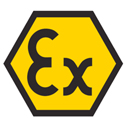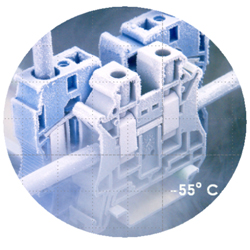Reliability is the keyword in Process Engineering. Its electrical system, the quality of the electrical contact points, is a major consideration for the reliability of the overall system. And how do you define reliability in a system? Is it in the Programmable Logic Controller (PLC), the drives’ system, or the Distributed Control System (DCS)?
In fact, the reliability of a system lies in the points where wires meet, or commonly referred to as connectors. In industrial application, it is widely known as terminal block.
Environmental factors have a major influence on the electrical system, in particular heat, cold and aggressive media. Flammable materials are often present or even processed in process plants, therefore, safety is paramount. This applies not only to the petrochemical industry, but also to the mining and food industry. Considerable risk potential is present as a result of explosive dusts.
Since July 2003, the ATEX 100a directive has been applied to equipment and protective systems in potentially explosive environments. To ensure sufficient explosion protection, it specifies increased requirements for electrical components and equipment. The constructional basis, in addition to the relevant regulations for modular terminal blocks, consists of special standards such as IEC 60079 (EN 60079) for equipment used in potentially explosive environments.
IEC 60079
The National Electric Code (NEC) and the Canadian Electrical Code (CEC) are used as the standards for North America. The directive 94/9/EC (ATEX 100a) has been of particular importance to manufacturers of equipment and protection systems in CENEL-EC countries of the European Community and beyond since 1 Jul 2003.
Increased Safety Ex e-certified terminal blocks
 Increased safety Ex E allows use as protection type in zone 2 and above all in zone 1, the actual potentially explosive area. However, this is only on the condition that the terminal blocks are accommodated in connection boxes that are also approved for Ex e – increased safety protection and have the equivalent of at least IP54 protection.
Increased safety Ex E allows use as protection type in zone 2 and above all in zone 1, the actual potentially explosive area. However, this is only on the condition that the terminal blocks are accommodated in connection boxes that are also approved for Ex e – increased safety protection and have the equivalent of at least IP54 protection.
Requirements for modular terminal blocks
The key requirements for modular terminal blocks are:
- Air and creepage distances
- Modular terminal blocks must be secured against loosening; fastened and designed so that the conductors cannot come loose or be impermissibly damaged by the terminal point
- The contact pressure must not be transmitted via insulating parts
- Modular terminal blocks that are intended for the connection of multi-wire conductors must be fitted with an intermediate elastic element
These requirements and the technical data has to be checked by an independent testing centre (notified body e.g. KEMA, TUV etc) and certified with the certificate of design approval.
The following tests must be verified by the type examination:
- Type test in acc. With IEC 60947-7-1/-2
- Proof of air and creepage distances and insulation testing
- Ageing test:
- 14 days of storage at 95 degree Celsius and 95% humidity
- A further 14 days with dry heat at the level of the TI value of the insulation material with subsequent conductor pull-out test.
Protection type Ex i
No special approval is required for modular terminal blocks in applications with the protection type Ex i “intrinsic safety”. An increase for air and creepage distances requirement is required,
- Between neighbouring terminal blocks
- Between terminal blocks and grounded metal parts
as well as distances through solid insulation are specified in IEC/EN 60079-11
Temperature shock test
As mentioned earlier, rapid changes in temperature frequently occur near process-related sources of heat and cold in process engineering.
This test verifies the consistently high contact quality of the terminal points even with rapid temperature changes.
For testing purposes, modular terminal blocks can be mounted on the fixing support and wired to a conductor of the rated cross section.
The structure is subjected to rapid temperature changes using a two-chamber method.
The temperatures are maintained close to the upper and lower limits of the modular terminal blocks. This is generally a temperature ranges of -55 degree C to +100 degree C.
The dwell time in each climatic chamber is 45 minutes, whereby the changes take place within a few seconds. This change takes place over 100 cycles.
The requirements are fulfilled if, after the test, the individual parts are undamaged and their further usage is guaranteed. After the modular terminal block has cooled down to room temperature, it must go through a voltage drop test.
Corrosion test
Corrosion-free contact areas are a prerequisite for low-resistance and thus powerful connections. This testing method describes a corrosion test in condensation climates with an atmosphere that contains sulphur dioxide. Here, acidic compounds < ph 7 form and attack metal surfaces.
 When two litres of distilled water and one litre of sulphur dioxide (SO2) gas are introduced to the test chamber, sulphurous acid forms at a testing temperature of 40 degree C for the duration of the test.
When two litres of distilled water and one litre of sulphur dioxide (SO2) gas are introduced to the test chamber, sulphurous acid forms at a testing temperature of 40 degree C for the duration of the test.
After eight hours, the test objects dry for 16 hours with the door open. After the end of the test, the test objects are inspected visually and the contact resistance is measured to describe the influence of this corrosion test on the contact point in detail.
Conclusion
If, after reading some of the tests described, you feel that you had underestimated the complexity of a simple terminal block, then you are not alone. Sadly, many engineers, professional ones included, are still ignorant about it. What is seen as the least important component in a system such as terminal block, can and will turn out to be your worst nightmare. This can range from simple system failures to the scope of endangerment to human life.
What does that translate into for a business? Production delays and downtime. From an economic perspective, it means a loss in investment. As the saying goes: “Penny-wise, Pound-foolish”.



Couldnt agree more with that, very attractive article
what are the most widely used terminal blocks in asia?
To answer this question, I have to first understand Asia. The fact remains that we cannot round up Asia with a particular trend or feature as these 11 countries in Asia are unique and very different from one another.
Answering to the best I can, I would do it by first analysising the market and look for the biggest industries where electrical connections are needed. In this context, I must say that the industry is probably infrastructure – buildings, energy, telecommunications etc, another words, general industries. Secondly, I will also analyse the numbers and the nature of developing nations vs the developed nations in Asia. As a whole, in Asia, I must say that we have a lot more developing nations than developed ones, and lastly, looking at the economic point of view, general income level is far lower than that of the Europe or North Americas.
These analyses summed up that the market of Asia is where supremacy lies in price over quality,whenever possible.
From another perspective, the tendency to answer this question directly, will be sided to the ‘chocolate-bar’ or barrier strip types of connection. But, in recent years, I can also see the trend of using modular terminal blocks in general industries. with such a step towards quality superiority, I am having second doubts that there is one clear domination of the types of terminal blocks used. For example, there is clearly a domination of modular terminal blocks in the industries of Oil & Gas, Pharmaceutical, Food and Beverage, Water and Waste Water treatment, Traffic and Automotive. And a clear domination in that of general industries in terms of ‘chocolate-bar” or barrier strips kind of terminal blocks in building, households etc.
The answer therefore, is 50:50, barrier strips vs modular terminal blocks, to answer it “safely”.
One thing that I can see obviously very clearly, the sunset types of terminal blocks definitely goes to the chocolate-bar”/barrier-strip with its phyical design limitation. Also, what is in the trend that I could see in the next decade, is the transformation of screwless, fast and reliable connections in all kinds of industries. We can already see the early-adoptors coming fast-and-furious with screwless connection, in particular to the use of Push-In Techology (PIT) by Phoenix Contact. A fast, reliable, robust (as screw-types), space-saving and reasonably priced PIT for the savvy-users. This trend is continuing with more and more users getting their reassurance of the reliability after doing trial-sampling in small sections of their plants for many months.
Taking this opportunity, should any users want a shot to test out the screwless PIT technology, feel free to come to us and we will be most willing to provide reasonable free samples for testing.